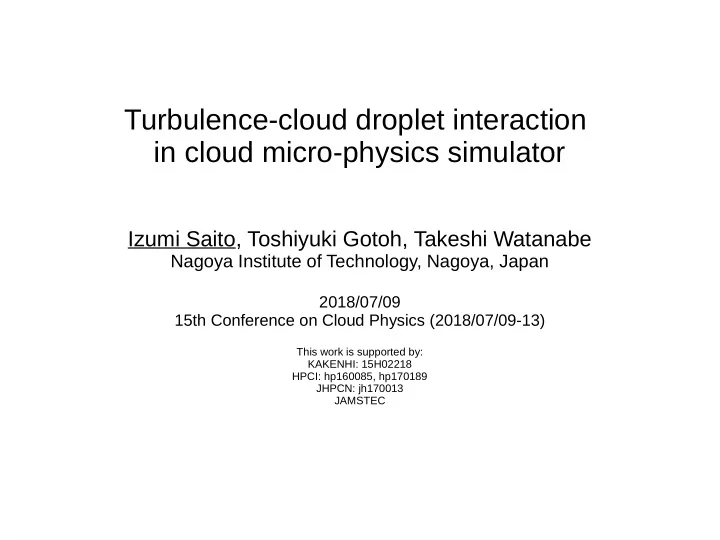

Turbulence-cloud droplet interaction in cloud micro-physics simulator Izumi Saito, Toshiyuki Gotoh, Takeshi Watanabe Nagoya Institute of Technology, Nagoya, Japan 2018/07/09 15th Conference on Cloud Physics (2018/07/09-13) This work is supported by: KAKENHI: 15H02218 HPCI: hp160085, hp170189 JHPCN: jh170013 JAMSTEC
Cloud microphysics simulator Turbulence, Mixing, Transport, Molecular dynamics and Droplet dynamics Spectral method + Lagrangian dynamics 0.5 mm < r < 1m 1ms < t < 20 min. wet dry aerosol small ice crystals rain drops Turbulent Mixing evap. 間欠性 condensatjon よどみ点 buoyancy 渦 〜 1m collision/ cloud coalescence 非一様分布 droplets Collision/Coalescence T wo phase fmow : LBM 2
Chandrakar et al (2016 、 PNAS) ( C16 ) ● Moist R-B convection ( turb. ) Low temperature ● Aerosol injection at const. rate ● Condensation nucleation →Condensation growth →Removal (⇒ steady state ) large PDF small Rayleigh- High temperature Benard Convection (Turbulence) Drop Diameter
C16: Statistical theory and experimental results Langevin Model Chandrakar et al (2016 、 PNAS) System time scale phase turb. relax. time
Purpose of the present study ● To compare DNS results with statistical relationships proposed by Chandrakar et al. (2016, PNAS) for validation of our model.
Model configuration - Condensation growth/decay - Lagrangian motion Particle injection at constant rate Particle removal with residential time scale (External) supersaturation (Ss) ⇒ Statistically steady state fluctuation PDF(r) PDF(Ss) Particle radius (r)
Governing equations for DNS Force (Gaussian white) - Gravity - Droplet inertia - Collision - Buoyancy Aerosol effect
Injected aerosol particle : NaCl aq Liquid water + NaCl r=0.39 [μm] NaCl, r=50 [nm] 0.39 [μm]
Parameters Box length Residential time scale RMS velocity Ss fluctuation without droplets Mean Ss in equilib. state Number of grids Integration time (5 million steps)
Experimental setups Run Aerosol Injected particle Mean radius Mean number Phase relax. [μm] density time effect radius [/cm^3] [s] [μm] 1 No 20 20 77 2.0 2 No 20 20 160 1.0 3 No 20 20 320 0.50 4 No 20 20 640 0.25 5 Yes 0.39 5.2 77 7.8 6 Yes 0.39 4.9 160 4.1 7 Yes 0.39 4.4 320 2.2 8 Yes 0.39 3.8 640 1.3
Questions to be answered ● For DNS, is there a proper choice for τ_t (time scale representing for turbulent mixing)? Yes. If so, is it equivalent to large-eddy turnover time, or velocity Lagrangian correlation time? No, but the difference is not so large (for our DNS results). ● What is a proper time scale for diffusion coefficient? Lagrangian autocorrelation time for Ss. ● How aerosol effects could be included in theory? By reflecting wall boundary condition (to a 1st approximation).
How to include the aerosol effect in theory? Droplet growth in fluctuating Ss Brownian motion with aerosol effect with reflecting wall Siewert et al. 2017, JFM
Steady state solution with source and sink source sink turbulence Reflecting wall boundary condition: (Steady state solution) (* Factor 2 disappeared )
Size distribution in steady state Theory (Normalization) Experimental results Normalized PDF PDF for R
Lagrangian Phase System autocorrelation relaxation time scale Exp. Theory time scale time scale results for Ss Run 5 41 43 0.50 0.68 7.8 Run 6 37 38 0.45 0.63 4.1 Run 7 31 32 0.42 0.56 2.2 Run 8 24 26 0.38 0.47 1.3 ⇒ Fairly good agreement
Summary ● Statistical relationships proposed by Chandrakar (2016, PNAS) were carefully reexamined and used for validation of our DNS. ● There is a proper choice of τ_t in DNS, but it is slightly larger (by about 25%) than the large-eddy turnover time. ● Scalar (supersaturation) Lagrangian autocorrelation time should be used for time scale of diffusion coefficient. ● Aerosol effect can be included in theory by reflecting wall boundary condition to a first approximation [consistent with Siewert et al. (2017, JFM) ]. ● Theory and DNS results agree very well. ⇒ C16 statistical theory is useful also for DNS.
Recommend
More recommend